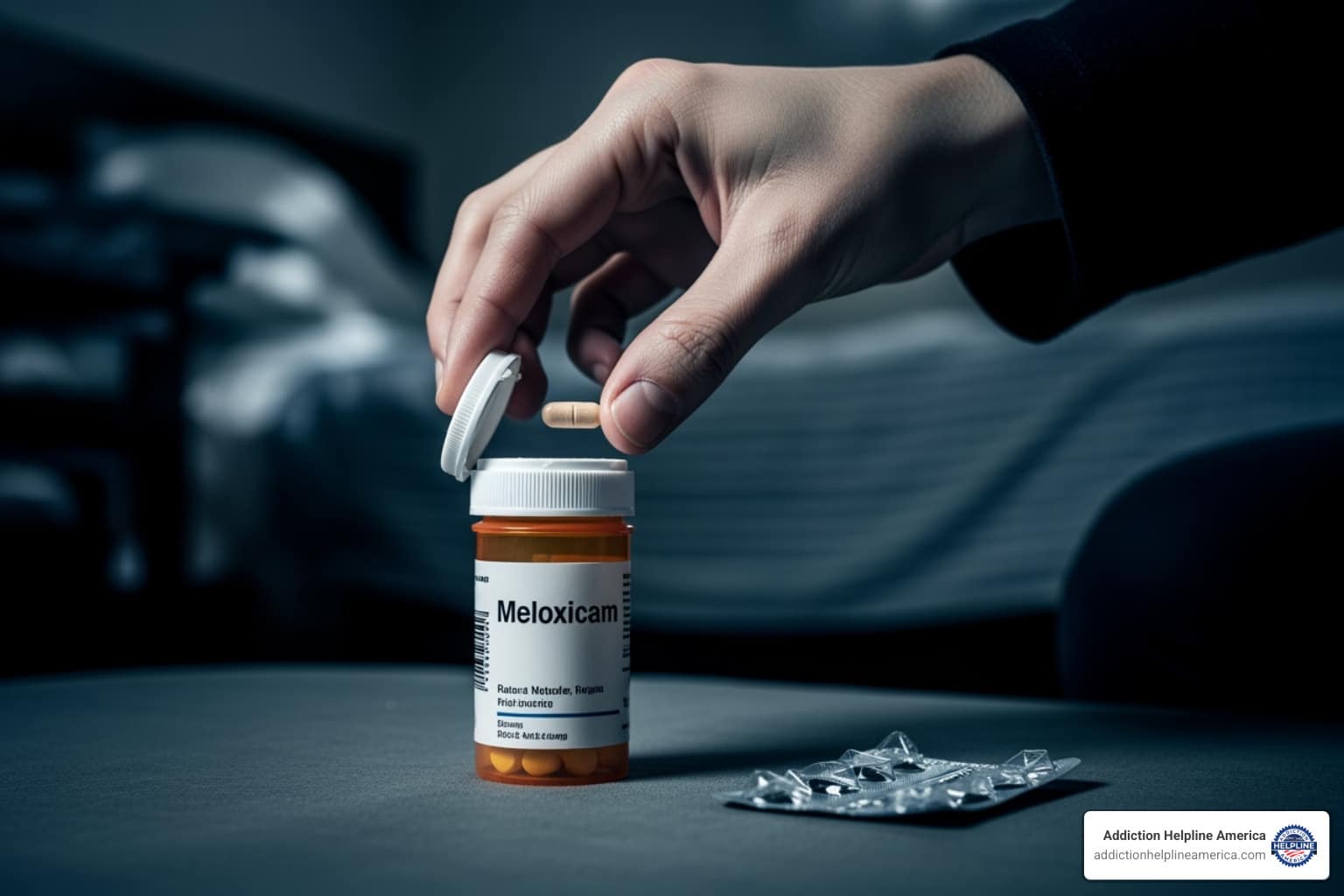
Understanding Meloxicam: What You Need to Know About This Common Pain Reliever
Meloxicam addiction is a topic surrounded by confusion and misconceptions. Here’s what you need to know right away:
Key Facts About Meloxicam:
- Not physically addictive – Meloxicam is a nonsteroidal anti-inflammatory drug (NSAID), not an opioid
- No euphoric effects – It doesn’t produce a “high” or affect the brain’s reward pathways
- Psychological dependence possible – Some people may develop a reliance on it for pain management
- Can be misused – Taking more than prescribed or using without a prescription carries serious health risks
- Dangerous side effects – Overuse can lead to stomach bleeding, heart problems, kidney damage, and liver injury
Many people assume all prescription painkillers are addictive like opioids. This isn’t true for meloxicam. While it can be misused—especially by people who mistakenly believe it contains opioids or who struggle with chronic pain—it doesn’t create the physical dependence that defines true addiction.
The real danger with meloxicam isn’t addiction in the traditional sense. It’s the serious health complications that can result from taking too much, combining it with other substances like alcohol, or using it long-term without medical supervision.
At Addiction Helpline America, we’ve guided countless individuals and families through concerns about prescription medication misuse, including meloxicam addiction and dependence issues. Our team understands the complex relationship between pain management, medication use, and the path to recovery.
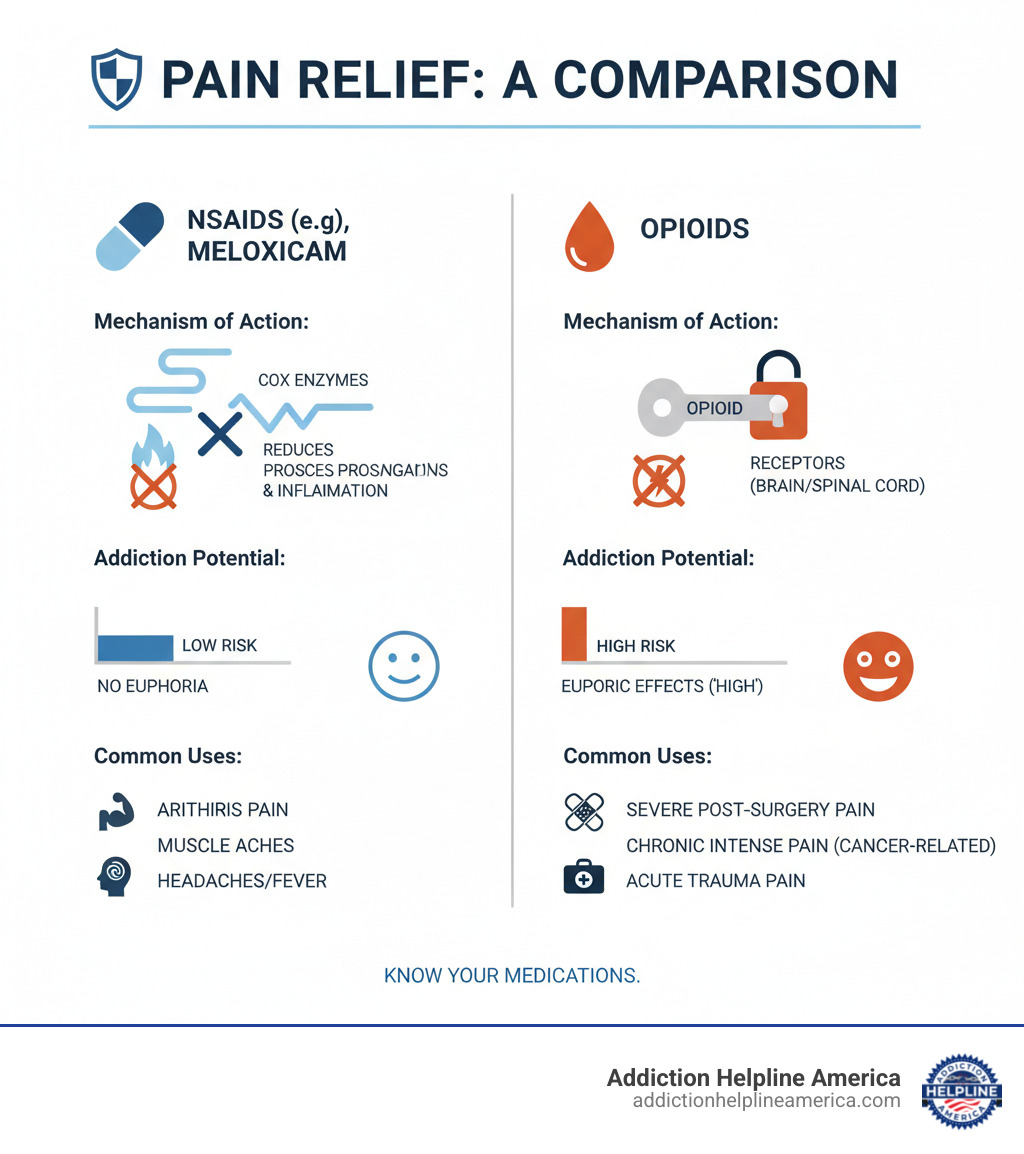
Know your meloxicam addiction terms:
What is Meloxicam and How Does It Work?
If you’ve been prescribed meloxicam, you’re using a prescription-strength nonsteroidal anti-inflammatory drug (NSAID). It’s sold under the brand names Mobic or Vivlodex in the United States. Unlike over-the-counter options like ibuprofen, meloxicam requires a prescription due to its potency.
Concerns about meloxicam addiction often stem from a misunderstanding of how it works. Unlike opioids, which alter pain perception in the brain and can cause euphoria, meloxicam targets the source of the problem.
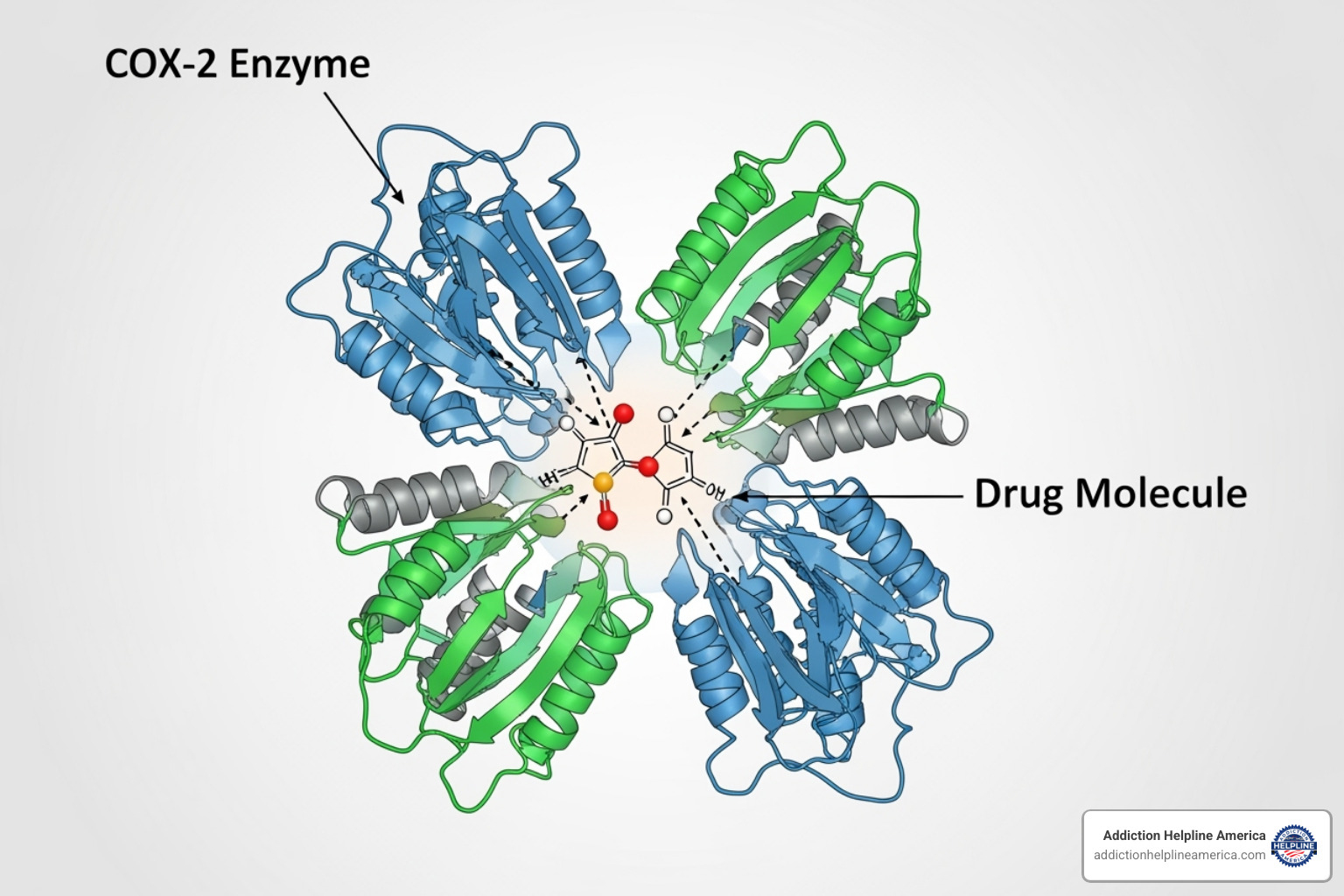
Meloxicam works by blocking COX-2, an enzyme that produces chemicals called prostaglandins. These prostaglandins trigger inflammation and pain. By reducing them, meloxicam eases pain and swelling without producing a “high” or affecting the brain’s reward system. This is why it’s considered a safer alternative to opioids for certain types of pain.
What makes meloxicam somewhat special among NSAIDs is its selectivity for the COX-2 enzyme. This generally makes it easier on the stomach than older NSAIDs, though risks still exist. You can learn more about how NSAIDs work from the FDA’s scientific information on nonsteroidal anti-inflammatory drugs.
What is Meloxicam Prescribed For?
Doctors most commonly prescribe meloxicam for arthritis-related conditions, and it is FDA-approved for osteoarthritis, rheumatoid arthritis, and juvenile rheumatoid arthritis. It is also prescribed “off-label” for other inflammatory issues like post-operative pain. The goal is always to reduce inflammation, allowing for more comfortable movement. For detailed information, you can review the FDA-approved prescribing information for meloxicam.
Understanding what meloxicam is—and isn’t—helps clarify why concerns about meloxicam addiction are often misplaced. It’s an anti-inflammatory, not a narcotic.
The Truth About Meloxicam Addiction
Let’s clear this up: when people worry about meloxicam addiction, they’re often confusing it with opioid addiction. Meloxicam is fundamentally different.
Meloxicam is not a narcotic and not a controlled substance. It doesn’t create the euphoric “high” that makes opioids dangerous. Opioids work by flooding the brain’s reward pathways with dopamine, which can lead to compulsive drug-seeking. Meloxicam simply reduces inflammation and pain without affecting brain chemistry in that way.
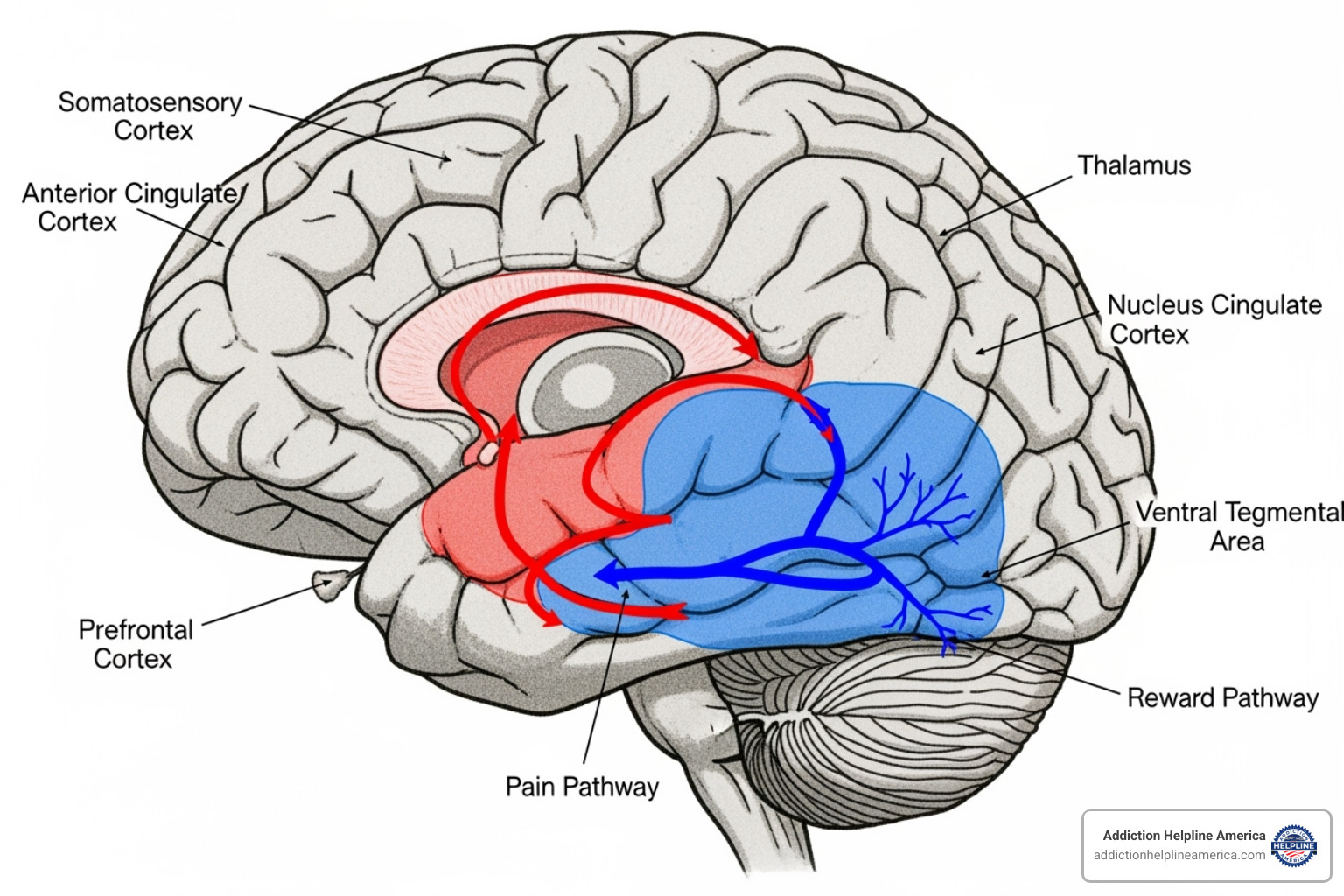
This misconception is understandable. After seeing the devastation of the opioid crisis, it’s natural to be wary of all prescription painkillers. However, meloxicam is often prescribed because it provides pain relief without the addiction risk of opioids.
Is a True Meloxicam Addiction Possible?
No, not in the traditional sense. A true physical meloxicam addiction is extremely unlikely because it doesn’t trigger the neurological changes that drive addiction. There are no physical cravings or withdrawal symptoms when you stop taking it.
Tellingly, meloxicam has virtually no street value. A 2011 DOJ report noted that out of $56 million in drug seizures in New England, only $200 was meloxicam. It doesn’t produce a high, so there’s no illicit market for it. Research on meloxicam focuses on its therapeutic effects and side effects, not addictive properties.
However, psychological dependence is possible. This happens when someone becomes mentally reliant on the medication, believing they can’t function without it due to fear of returning pain. This isn’t a chemical craving but a psychological safety net that can be hard to give up.
Why Do People Misuse Meloxicam?
If it’s not addictive, why is it misused? The reasons are complex.
- Mistaking it for an opioid: Some people assume meloxicam is an opioid and take high doses seeking a “high” or to ease opioid withdrawal, not realizing it’s an NSAID until they’ve already taken a dangerous amount.
- Inadequate pain relief: People with severe chronic pain may take more than prescribed, not to get high, but simply to stop the pain. A 2018 study found over 15% of adults exceeded the daily NSAID dose in one week, often out of desperation.
- Polydrug abuse: Some misuse meloxicam to relieve hangover symptoms. This is extremely risky, as combining it with alcohol significantly increases the risk of severe stomach bleeding and ulcers. By masking hangovers, it can enable a dangerous cycle of binge drinking.
- Self-medicating emotional pain: Some use meloxicam to cope with stress or anxiety. While it offers no psychological relief, this behavior can lead to psychological dependence, where a person believes they need the drug to function emotionally.
While meloxicam won’t hijack your brain’s reward system, misusing it can cause serious health problems. If you find yourself taking more than prescribed or feeling like you can’t function without it, those behaviors suggest an underlying struggle that deserves professional attention.
Recognizing the Dangers: Meloxicam Abuse and Overdose
Even though meloxicam addiction isn’t a physical dependency, misusing the medication is still dangerous. Taking more than prescribed, using it more often, or taking someone else’s prescription carries serious health risks.
Spotting meloxicam abuse can be tricky, but key warning signs include:
- Taking more than prescribed or running out of medication early.
- “Doctor shopping” to get multiple prescriptions.
- Developing tolerance (needing more for the same effect).
- Continued use despite negative consequences to health, work, or relationships.
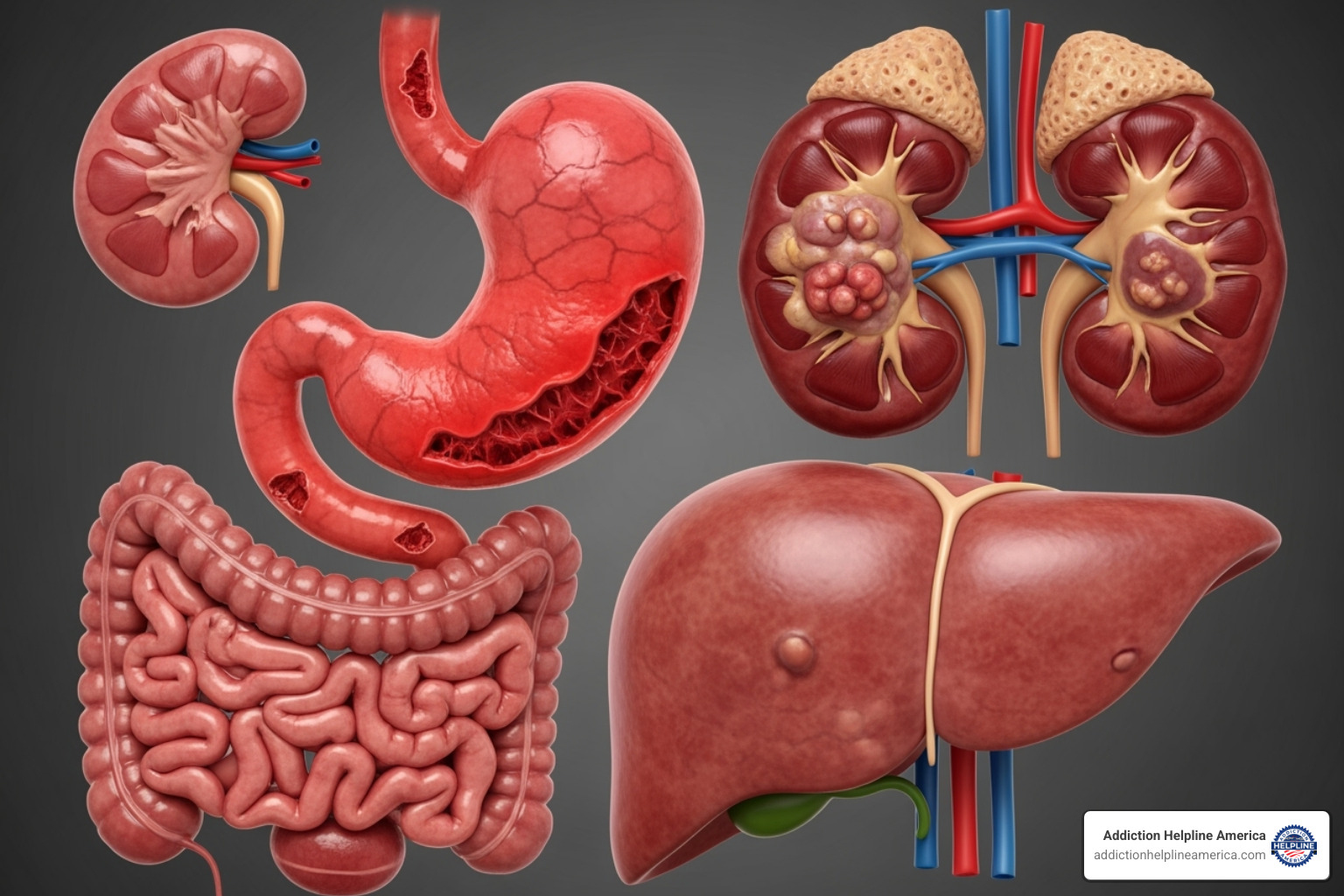
Common and Serious Side Effects
Every medication has potential side effects. Common side effects of meloxicam are typically manageable and may include diarrhea, constipation, gas, stomach pain, heartburn, nausea, dizziness, or a sore throat. While uncomfortable, these are not usually dangerous. You can find more details from resources like MedlinePlus.
The real danger of meloxicam misuse lies in severe health complications, especially with high doses or long-term use.
- Gastrointestinal bleeding and ulcers: Meloxicam can cause bleeding or ulcers in the stomach or intestines. Seek immediate medical attention for severe stomach pain, black or tarry stool, or vomit that looks like coffee grounds. The risk is much higher when combined with alcohol or smoking, as smoking dramatically increases the chances of gastrointestinal bleeding with NSAIDs.
- Heart and blood vessel risks: Meloxicam can increase the risk of a heart attack, stroke, or blood clots. The FDA warns that this risk grows with higher doses and longer-term use.
- Kidney damage: The drug can cause acute or long-term kidney injury. Symptoms include decreased urination, unexplained swelling, or sudden weight gain.
- Liver injury: Though less common, liver damage can occur. Watch for jaundice (yellowing skin or eyes), dark urine, or persistent nausea and fatigue.
These serious side effects can develop silently, which is why adhering to your prescribed dosage and maintaining contact with your doctor is essential for your safety.
Signs of Meloxicam Overdose
According to the FDA, true meloxicam overdoses are rare, but they can happen. An overdose is a medical emergency.
Symptoms of a meloxicam overdose can include:
- Extreme lethargy or drowsiness
- Nausea and stomach pain
- Vomiting blood or material that looks like coffee grounds
- Black, tarry, or bloody stool
- Difficulty breathing
- Seizures
- Coma
If you suspect an overdose, call 911 or go to an emergency room immediately. There is no specific antidote; medical care is supportive and focuses on managing symptoms. For more guidance, see what to do in case of an overdose.
Finding Help for Meloxicam Misuse
If you’re worried about your use of meloxicam or that of a loved one, reaching out for help is a sign of strength. At Addiction Helpline America, we understand the confusion around issues like meloxicam addiction, especially when chronic pain is involved.

Getting professional help is about understanding why the misuse began. Whether it’s due to unmanaged pain, stress, or mixing substances, a professional can help you develop safer strategies and address any co-occurring mental health concerns. You don’t have to do it alone. Our team provides free, confidential guidance to connect you with the right treatment program from our nationwide network.
Alternatives to Meloxicam for Pain Management
A major fear when addressing meloxicam misuse is the return of pain. Fortunately, many effective alternatives exist. Work with your healthcare provider to find the right approach for you.
- Other Medications: Other NSAIDs like naproxen (Aleve) or celecoxib (Celebrex), or non-inflammatory pain relievers like acetaminophen (Tylenol), may be suitable.
- Physical Therapy: A physical therapist can help build strength and improve flexibility, often reducing pain without medication.
- Complementary Practices: Yoga and acupuncture can help manage chronic pain by reducing stress and promoting relaxation.
- Lifestyle Changes: An anti-inflammatory diet (rich in fruits, vegetables, and omega-3s) and stress management techniques like meditation can significantly impact pain levels.
Treatment for Psychological Dependence on Meloxicam
Since meloxicam isn’t physically addictive, there’s no detox or physical withdrawal. However, the original pain will return upon stopping, which can be distressing. Treatment for psychological dependence focuses on building healthier coping skills.
- Cognitive Behavioral Therapy (CBT): This therapy helps you identify and challenge negative thought patterns about pain and medication, such as believing you can’t function without it.
- Counseling and Support Groups: Individual or group counseling explores the root causes of misuse. Support groups connect you with peers who understand your struggles, reminding you that you’re not alone.
- Developing New Coping Skills: Treatment emphasizes learning practical techniques to manage pain, stress, and emotional triggers without over-relying on medication.
If co-occurring disorders like opioid or alcohol addiction are present, treatment may include medication-assisted treatment (MAT). Your team will also help find safer ways to manage legitimate chronic pain. At Addiction Helpline America, we connect people with programs offering these therapies. Find the right treatment program for you and take the first step toward a healthier life.
Frequently Asked Questions about Meloxicam
We hear these questions all the time at Addiction Helpline America. Let’s tackle the most common ones about meloxicam.
Is meloxicam a narcotic or an opioid?
No. Meloxicam is not a narcotic or an opioid. It is a non-steroidal anti-inflammatory drug (NSAID), similar to ibuprofen.
Opioids work by binding to receptors in the brain to block pain perception and create euphoria. Meloxicam works differently by reducing inflammation at the source of an injury. It does not act on opioid receptors, does not cause a “high,” and does not carry the risk of physical addiction associated with narcotics. For more details, the FDA’s information on NSAIDs provides a scientific overview.
Are there withdrawal symptoms from stopping meloxicam?
No, there are no physical withdrawal symptoms from stopping meloxicam because it doesn’t cause physical dependence. However, the pain and inflammation it was treating will likely return. This return of symptoms is not withdrawal or a sign of meloxicam addiction; it’s the original medical condition reasserting itself. It’s important to talk to your doctor before stopping so they can help you transition to another pain management strategy.
How is meloxicam different from ibuprofen?
Both are NSAIDs, but they have key differences:
- Strength and Availability: Meloxicam is a stronger, prescription-only medication. Ibuprofen (Advil, Motrin) is available over-the-counter, though higher doses can be prescribed.
- Dosing: Meloxicam is taken once daily due to its long half-life (15-20 hours), which is convenient for chronic conditions. Ibuprofen must be taken every 4-6 hours.
- Selectivity: Meloxicam is more selective in targeting the COX-2 enzyme, which may lead to fewer stomach issues at prescribed doses compared to ibuprofen. However, both carry risks for gastrointestinal and cardiovascular problems.
- Approved Uses: Meloxicam is primarily for chronic arthritis, as per its FDA-approved prescribing information. Ibuprofen is approved for a broader range of issues, including fever, headaches, and acute pain.
Your doctor prescribes meloxicam when its specific properties are a better fit for your condition. Neither carries the addiction risk of opioids, but that doesn’t mean they are without risk or cannot be misused.
Take Control and Find Support
Throughout this article, we’ve walked through the realities of meloxicam together—clearing up the confusion about whether it’s truly addictive and exploring what actually happens when this medication is misused.
Here’s what we want you to remember: Meloxicam is not physically addictive like opioids. It doesn’t hijack your brain’s reward system or create the chemical dependence that defines true addiction. But that doesn’t mean there aren’t real concerns. Psychological dependence can develop, especially when you’re dealing with chronic pain and feel like you can’t manage without your medication. And the dangers of misuse? Those are very real and can be life-threatening.
Taking more meloxicam than prescribed, combining it with alcohol, or using it without proper medical supervision puts you at serious risk for gastrointestinal bleeding, ulcers, heart attack, stroke, and damage to your kidneys and liver. These aren’t abstract possibilities—they’re documented complications that can change your life or end it.
If you’re reading this because you’re worried about yourself or someone you love, we want you to know something important: seeking help is not a sign of weakness. It’s actually one of the strongest things you can do. Whether you’re struggling with how to manage chronic pain without misusing medication, dealing with psychological dependence, or simply feeling confused and overwhelmed about your prescription use, you don’t have to figure it out alone.
At Addiction Helpline America, we’ve helped thousands of people steer exactly these kinds of concerns. We understand that meloxicam addiction and misuse often stem from a genuine need for pain relief, not from reckless behavior. We know that finding the right balance between managing your pain and protecting your health can feel impossible sometimes. And we’re here to help you find that balance.
Our team provides free, confidential, and personalized guidance to connect you with treatment programs that understand your unique situation. We work with a vast network of addiction and mental health treatment centers across the country, so we can help you find the right support—whether that’s pain management specialists, behavioral therapy, counseling, or comprehensive treatment for co-occurring substance use issues.
You deserve to live without constant pain, but you also deserve to be healthy and safe. Let us help you find a path forward that honors both of those truths.
Our helpline is 100%
free & confidential
If you or someone you care about is struggling with drug or alcohol addiction, we can help you explore your recovery options. Don’t face this challenge alone—seek support from us.
Programs
Resources
Will my insurance
cover addiction
treatment?
We're ready to help
Find the best
drug or alcohol treatment
center
Are you or a loved one struggling with addiction? Call today to speak to a treatment expert.












